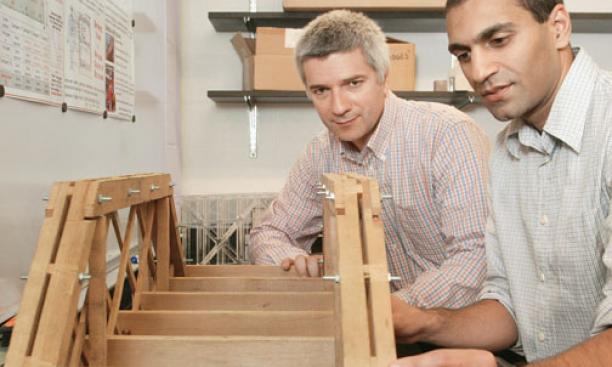

If bridges could talk, some would warn us that they are old, potentially hazardous, and need repair. A new technology being developed at Princeton has the potential to give bridges a voice, possibly preventing disasters like the 2007 collapse of an interstate-highway bridge in Minneapolis that killed 13 people.
“We really don’t have an adequate technology to provide structural information that is accurate enough and specific enough to be actionable,” said Naveen Verma, assistant professor of electrical engineering. That’s why Verma and Branko Glisic, assistant professor of civil and environmental engineering, along with professors James Sturm and Sigurd Wagner, set out to find a way to monitor the health of a bridge.

The team developed a sheet of sensors, a sort of wallpaper that can be placed over a large area of a bridge. Traditionally, sensors on a bridge have been sparse, and the data have been inconsistent and difficult to interpret. The new technology promises higher resolution because of a greater number of sensors, as well as simplified data processing thanks to built-in circuits that read the sensor data. “The structure manager can now have a color-coded image showing the location of any stress,” said Glisic. “The idea is to make it really easy to act based on the data.”
An appropriate analogy is the human body’s system of nerves, Glisic said: “If you have a cold, you are not going to the doctor, but if you feel strong pain in your stomach, you recognize that you need medical intervention.” The bridge-sensing technology is intended to work similarly, resulting in proper, timely maintenance, and not costly repairs of every minor crack.
“The sensor sheet under development at Princeton is an absolutely amazing technology with incredible potential,” said Jerome P. Lynch, associate professor in the department of civil and environmental engineering at the University of Michigan.
The team has a prototype the size of an 8.5-by-11-inch sheet of paper and is working on using solar energy to make the system self-powered. The technology will be tested on a model 15-foot bridge in the laboratory and then on Streicker Bridge, which crosses Washington Road near the Frick chemistry building.
The approach could also be applied to sense corrosion, wind, and temperature. “In 10 years we will have multifunctional wallpaper that can measure anything about the structure, and it will be self-powered and very intelligent,” said Glisic. The technology also could be applied to other structures — aircraft, buildings, and pipelines. “It has enormous potential,” he said.
